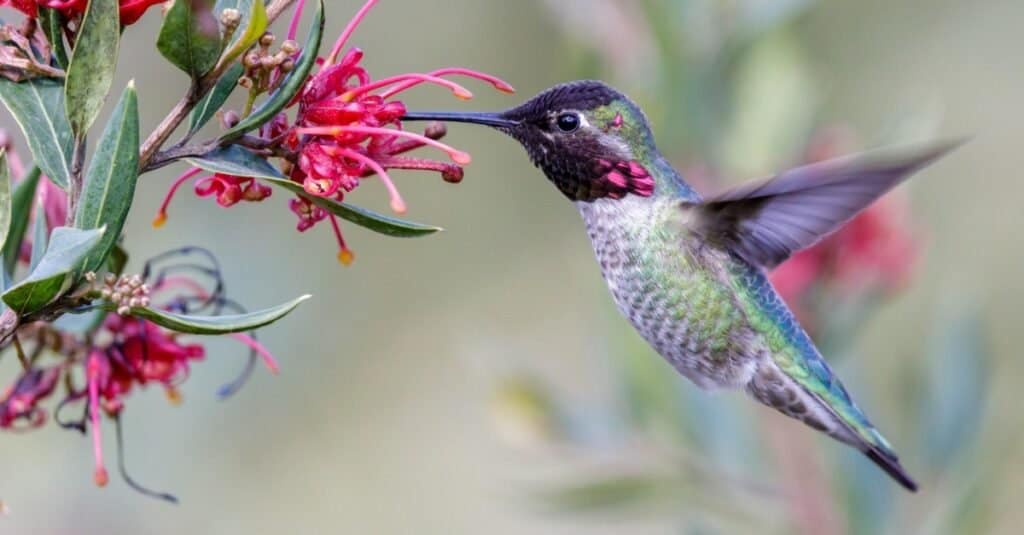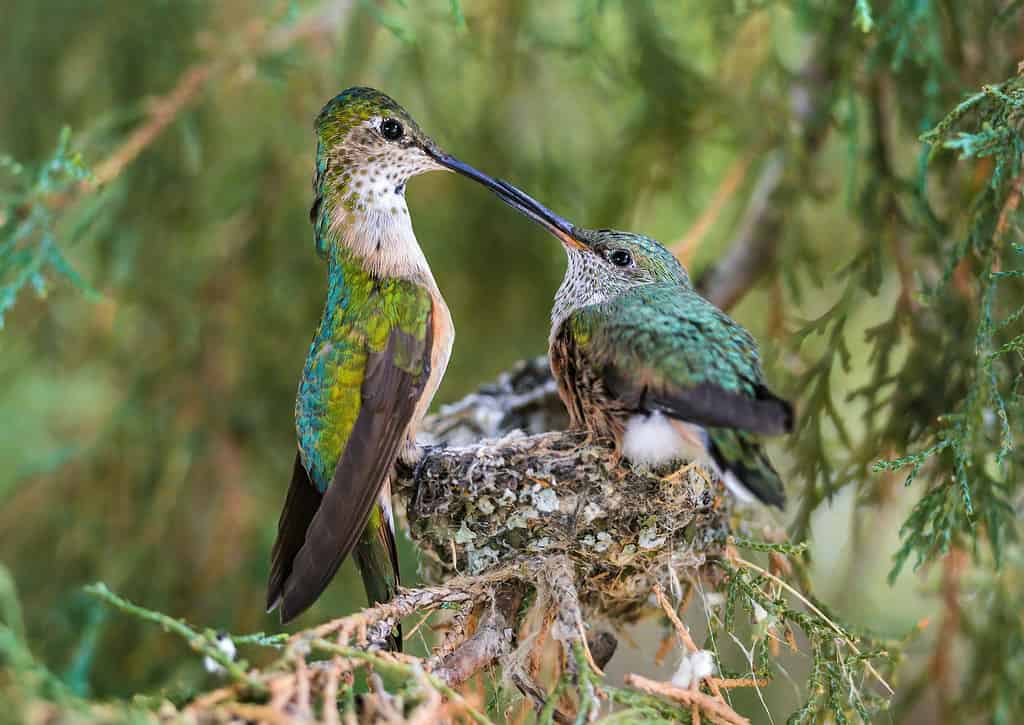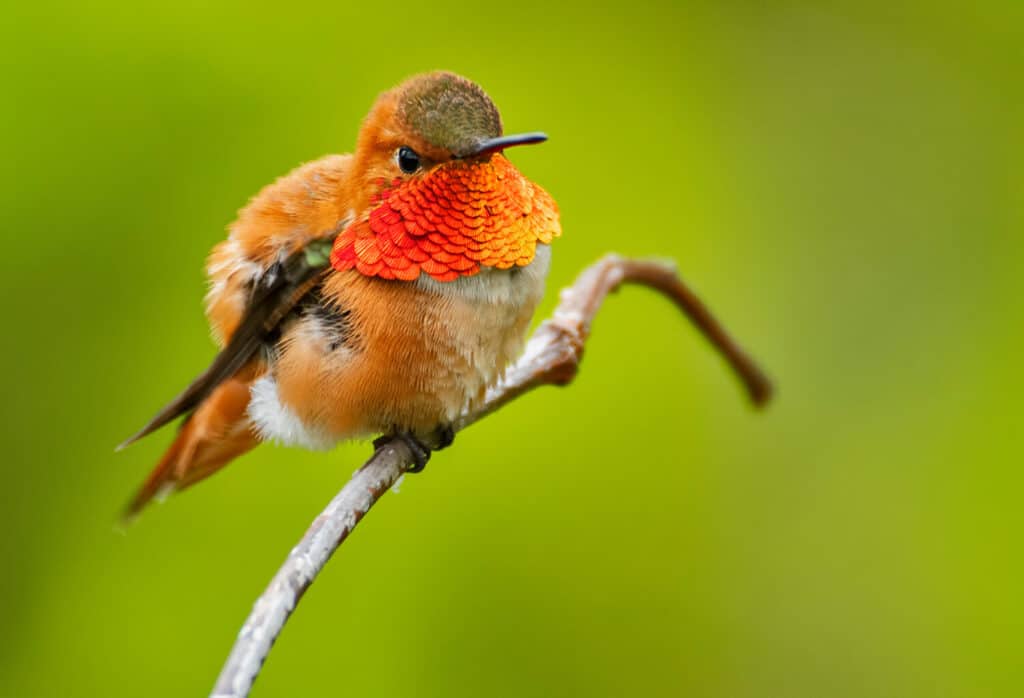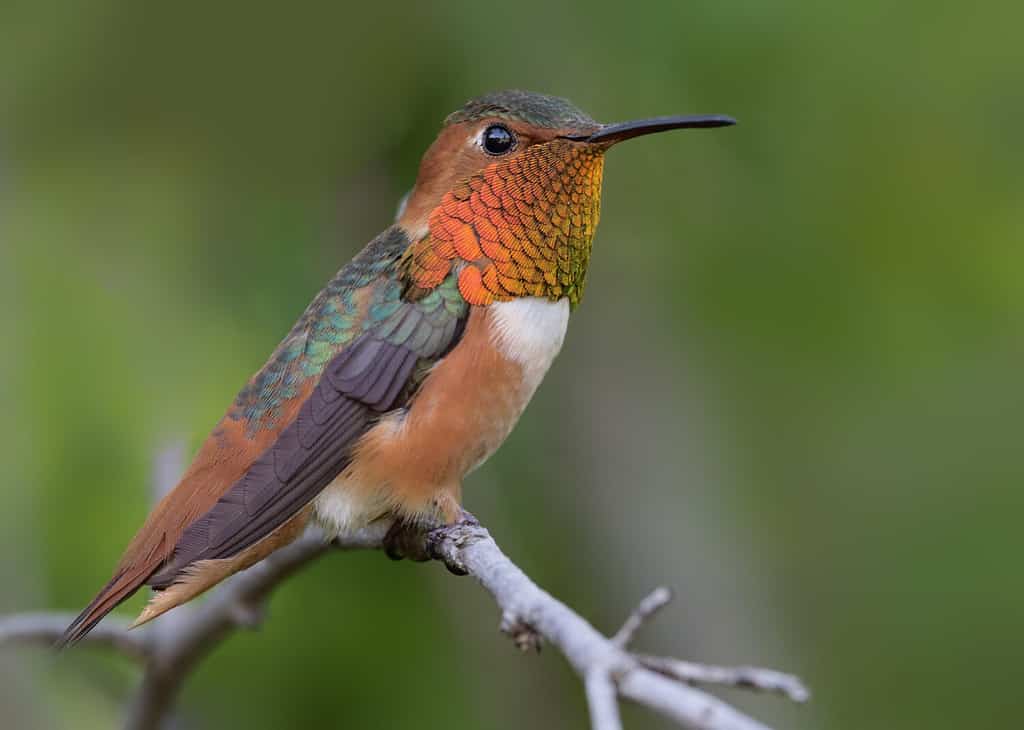Let’s learn about the enchanting hummingbirds in Oregon! Delve into the captivating world of these tiny, vibrant creatures as we explore seven distinct types found in this beautiful state. Discover their favorite plants and embrace the joy they bring to your garden.

1. Black-Chinned Hummingbird

The throat patch on a black-chinned
hummingbird
is actually purple.
©rck_953/Shutterstock.com
Black-chinned hummingbirds are a common sight in Oregon. These small birds are easily identifiable with their glossy green backs, purple throats, and black chins. The males have a glittering greenish-black tail, while the females have a grey one.
Black-chinned hummingbirds live in open woodlands and forests in Oregon. They often nest in shrubs and trees, such as willows, maples, and cottonwoods. You can also find them in gardens and backyards, attracted to the nectar of flowers and feeders.
Insects are the main source of food for black-chinned hummingbirds. They feed on small flies, bees, ants, moths, and other insects. They also enjoy the sweeter nectar of flowers, as well as syrup and sugar water from feeders.
Its summer habitat includes canyons, deserts, juniper woodlands, stream bottoms, and gulches. It is particularly rare in Klamath and Lake counties but is more commonly seen in the foothills of the Wallowa and Blue Mountains.
2. Anna’s Hummingbird

The tiny Anna’s Hummingbird is aggressive in protecting its territory and can dive to attack at up to 60 mph.
©iStock.com/yhelfman
Anna’s Hummingbirds are an incredibly unique species of hummingbird in Oregon. They have a distinctive physical appearance, featuring a green back, white chest, and pink neck. They have a slender bill and a long, forked tail. These birds measure between 3.5 and 4 inches in length and have a wingspan between 4.3 and 5.1 inches.
Anna’s Hummingbirds have a diet consisting of nectar, small insects, and spiders. They can consume up to twice their body weight in nectar each day. They also feed on sap from sapsucker holes and consume tree sap from broken branches.
These hummingbirds are able to tolerate temperatures as low as 28 degrees Fahrenheit and are one of the few species of hummingbird that remain in the Pacific Northwest during the winter. They are also territorial and aggressive, often chasing away other hummingbirds from their feeding grounds.
Anna’s hummingbirds live in valleys, along coastlines, and in urban developments. It is not as common once you travel west of the Cascade Mountains. You can see them in large numbers west of the Cascades, and in winter, they tend to hang out in the southwestern part of the state because it is warmest.
3. Costa’s Hummingbird

Given their small size, the migratory patterns of Costa’s hummingbirds are amazing.
©Takahashi Photography/Shutterstock.com
Costa’s Hummingbirds, Scientific Name Calothorax costae, inhabit Oregon’s shrub-steppe habitats. They have a vibrant bronze-green back, an iridescent throat patch, and a white breast. These hummingbirds have a body length of 3.5 inches and a wingspan of 4.25 inches.
Costa’s Hummingbirds mainly feed on nectar from flowers, tree sap, and small insects. If you are lucky, you can spot one hovering in the air while they catch insects. To conserve energy, these hummingbirds usually perch during the night.
The Costa’s hummingbird is an uncommon sight in Oregon, seen primarily during the spring and summer. However, males have been noted to stay in the Rogue Valley all year round. They are usually found in areas with little canopy cover, such as Bear Creek and the edge of Agate Lake, amongst tall white oaks. These birds can be hard to spot in Oregon due to their similarity with other hummingbird species.
4. Calliope Hummingbird

The Calliope Hummingbird is the smallest bird native to the United States and Canada.
©MTKhaled mahmud/Shutterstock.com
Calliope hummingbirds are some of the smallest birds in the world, measuring only 2.75 inches in length. These birds are easily recognizable by their vibrant green and white feathers, as well as their orange-red throats and crowns. They live in western North America and are most active in Oregon during the summer months.
These birds feed on tiny insects, nectar, and sap. They also enjoy eating fruit, such as blackberries. In order to get enough energy to fly, they may visit up to 1,000 flowers a day.
This tiny bird is the smallest of its kind in North America and the smallest long-distance migrating bird in the world. They weigh an average of 0.09 oz, which is only half of an Anna’s hummingbird and a little over the weight of a copper penny. They breed in mountain habitats and can endure the cold summer nights found at higher altitudes. It’s a frequent summer resident of the Blue Mountains and Wallowa Mountains, as well as other elevated places east of the Cascade Mountains.
5. Broad-Tailed Hummingbird

Females and immature birds have a dull green plumage on their back and wings, with a whitish-gray breast and belly.
©Susan Hodgson/Shutterstock.com
Broad-tailed hummingbirds are a stunning sight in the Oregon landscape. These birds have vibrant colors, with emerald green backs, ruby throats, and white-tipped tails. They measure around three inches in length and have long, curved bills.
During the breeding season, male broad-tailed hummingbirds are especially territorial and display their feathers in the air to attract mates. They feed on a variety of nectar and insects. They typically feed on small insects, such as aphids and mites, as well as nectar from a variety of plants.
Broad-tailed hummingbirds often migrate to Oregon during the warmer months. They tend to migrate in large groups, often numbering in the hundreds. During this time, they live near large bodies of water, such as lakes and ponds near the eastern border of Oregon.
Broad-tailed hummingbirds exhibit unique courtship rituals. The male will fly in a large circle around the female while emitting a high-pitched call. This display is intended to attract a mate and is often accompanied by an elaborate feather dance.
6. Rufous Hummingbird

These sassy hummingbirds have an extravagant courtship dance.
©punkbirdr/Shutterstock.com
Rufous hummingbirds in Oregon feature stunning iridescent feathers. They have a rusty-orange back and rufous-colored throat. The male also has a greenish-black crown and back. These birds have long, slender bills adapted for nectar feeding and short, rounded wings that allow for quick, agile flight.
Rufous hummingbirds in Oregon feed on nectar from flowers, and they also eat insects and spiders for protein. They feed by hovering in the air and using their long bills to probe flowers and catch insects. They also use the trees as perches to rest and to look for food.
The Rufous hummingbird is the most widespread species of hummingbird that you can see in Oregon. This bright reddish-brown bird is well-known for its boldness when it comes to feeding on nectar and is often spotted in many backyards. It tends to migrate through the majority of western Oregon and is commonly seen in wooded areas.
7. Allen’s Hummingbird

The vibrant colors of Allen’s hummingbirds are truly beautiful to behold.
©Angel DiBilio/Shutterstock.com
Oregon is home to Allen’s hummingbirds, a vibrant species that add a brilliant splash of color to its ecosystems. These tiny birds measure only around 4 inches in length and have a distinctive green back, a white breast, and a red throat.
Allen’s hummingbirds have a diverse diet, consisting of small spiders, ants, and aphids, as well as nectar from flowers and occasionally small fruits. To get food, they use their long, thin bills to probe flowers for nectar.
These hummingbirds live in coastal areas within the marine layer of the Pacific Ocean and in oak woodlands. You can often spot them often hovering in front of flowers in search of food. They are also frequent visitors to gardens and feeders, making them a popular species with birdwatchers.
It is related to the widely-found Rufous hummingbird with only small changes in its feathers, behavior, and sound. From spring until summer, it lives along the southern Oregon shore up to Bandon. In inland parts of western Oregon, people only spot them rarely.
10 Plants in Oregon That Attract Hummingbirds

A blooming lilac is a favorite food of Hummingbirds in Oregon.
©NikolayTsyu/Shutterstock.com
Trumpet Honeysuckle
Trumpet honeysuckle is a deciduous shrub native to Oregon. It is a popular choice for attracting hummingbirds to the garden, with its bright orange or yellow trumpet-shaped flowers. The nectar-rich blooms are especially attractive to hummingbirds, and the shrub can reach up to 8 feet tall.
Fireweed
Fireweed is an Oregon native wildflower that blooms from summer to fall. It has bright pink flowers that attract hummingbirds in search of nectar. The flowers are pollinated by hummingbirds and bees. Fireweed is a great addition to any garden, as it is low maintenance and easy to grow.
Columbine
Columbine is a low-growing perennial that is native to Oregon. It has brightly colored flowers with long spurs that are attractive to hummingbirds. The flowers are typically red, pink, yellow, or white, and they bloom in spring and summer. It is a great choice for attracting hummingbirds to the garden.
Western Bleeding Heart
A western bleeding heart is a perennial native to Oregon. Its heart-shaped flowers are a vibrant pink and attract hummingbirds. The flowers bloom in late spring and early summer and can reach up to 3 feet tall. Western bleeding heart is easy to grow and can thrive in most soil types.
Oregon Grape
The Oregon grape is an evergreen shrub native to Oregon. It has clusters of yellow flowers that attract hummingbirds. The flowers are followed by clusters of purple berries that are attractive to birds. The shrub is an excellent choice for attracting hummingbirds to the garden, as it is low maintenance and drought tolerant.
Western Azalea
Western Azalea is a deciduous shrub native to Oregon. It has clusters of fragrant, pink, or white flowers that attract hummingbirds. The blooms appear in late spring and early summer and after that, clusters of red berries. Western azalea is also evergreen and adds beautiful winter interest to the landscape.
Red Flowering Currant
Red flowering currant is a deciduous shrub native to Oregon. It has clusters of bright red flowers that attract hummingbirds. The flowers bloom in late spring and early summer. The plant then grows clusters of black-colored berries. Squirrels, robins, and woodpeckers also love red currant berries.
Wild Lilac
Wild lilac is a deciduous shrub native to Oregon. It has clusters of fragrant purple flowers that attract hummingbirds. The flowers bloom in late spring and early summer, just when many hummingbird species are very hungry after their migration. Wild lilac also smells amazing and makes a great cut flower.
Western Serviceberry
Western Serviceberry is a deciduous shrub native to Oregon. It has clusters of white flowers that attract hummingbirds. The flowers bloom in late spring and early summer and are followed by clusters of red berries. Skunks, foxes, and chipmunks all love the berries too!
Western Red Columbine
Western red columbine is a perennial native to Oregon. Its bright red flowers have long spurs that are attractive to hummingbirds. The flowers bloom in late spring and early summer and can reach up to 3 feet tall. Western red columbine will self-seed and come back year after year with no effort needed on your part.
The photo featured at the top of this post is © iStock.com/McBenjamen
Thank you for reading! Have some feedback for us? Contact the AZ Animals editorial team.







